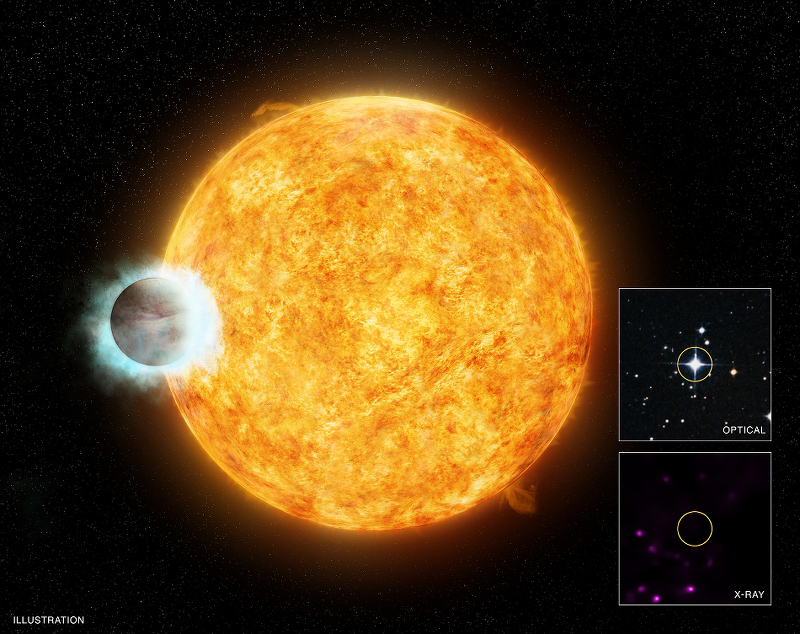
 Credit: X-ray: NASA/CXC/SAO/I.Pillitteri et al; Optical: DSS; Illustration: NASA/CXC/M.Weiss
Credit: X-ray: NASA/CXC/SAO/I.Pillitteri et al; Optical: DSS; Illustration: NASA/CXC/M.Weiss
Premature Aging
Young, low-mass stars are generally very active, producing lots of starspots, stellar flares and generating high-energy X-ray emission. Young stars tend to rotate very rapidly, and that rotation, combined with the convective circulation of the hot, ionized gas in its outer layers, generates strong magnetic fields. This same process happens on our Sun, and drives the solar activity cycle. But stars tend to spin more slowly as they age, so that, for a given star, the activity cycle weakens as the star ages. Because stellar activity produces X-ray emission, the relative amount of X-ray emission generally serves as a tracer of stellar age. Now astronomers believe they've identified an exception to this X-ray/age rule. An unusual star, WASP-18, seems to be an exceptionally inactive young star. X-ray observations with the Chandra X-ray Observatory show that WASP-18 emits no detectable X-rays, suggesting that the star is far less active than it should be, given its relative youth. Why is the star so quiet? As shown in the illustration above, WASP-18 is orbited by a close-in planet, WASP-18b, which is about ten times the mass of the planet Jupiter. But unlike Jupiter, which takes nearly 12 years to orbit the Sun, WASP-18b orbits WASP-18 in less than 23 hours. Astronomers suspect that the gravitational interaction between the massive planet and its star somehow suppresses the convection of the hot plasma below WASP-18's surface and thus reduces the high-energy X-ray emission from the star. The inset shows optical and X-ray images of WASP-18, illustrating the relative faintness of the star in X-rays. High-energy emission, and strong eruptions of matter from young active stars can play an important role in the evolution of the atmospheres of the star's planets. WASP-18b suggests that, while stellar activity can affect planets, perhaps planets can affect the activity of stars too.
Published: November 10, 2014
<
HEA Dictionary ● Archive
● Search HEAPOW
● Other Languages
● HEAPOW on Facebook
● Download all Images
● Education ● HEAD
>

Each week the HEASARC
brings you new, exciting and beautiful images from X-ray and Gamma ray
astronomy. Check back each week and be sure to check out the HEAPOW archive!
Last modified Tuesday, 27-Feb-2024 10:10:20 EST


